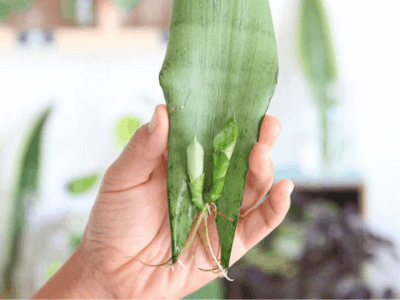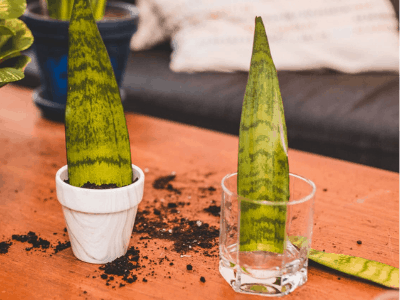It must be the most fun project ever to propagate snake plant, also known as Sansevieria, in water…
Setting it up is very straightforward. The hardest part is waiting!
We’ll explore watering snake plants in the next section! But first…
Hear it from Steven!
The snake plant is just a winning houseplant…
Not only that it’s easy care and low maintenance…
It’s also very easy to multiply these babies…
… simply by propagating them. Lots of methods to try from!
The simplest way is propagating it through leaf cuttings…
Generally, these cuttings are planted in soil medium…
But you can actually plant them in water, amazing right?
That’s true!
That’s why snake plants are a lot of people’s favorite…
This variety is the current moment’s “it” succulent. There’s a reason sansevierias are so popular, they’re practically indestructable.
Marc Hachadourian, the director of glasshouse horticulture at the New York Botanical Garden
The mother-in-law’s tongue is another common name for the plant…
Depending on where you come from, the common name may vary…
The botanical name, Sansevieria, is accepted universally…
Propagating Snake Plant In Water

In water, rooting snake plant is very easy. The process goes as follows:
- Look for a healthy leaf, but not one that is too old.
- Use a pair of sharp scissors to cut the leaf off.
- Leave the leaf cuttings to sit for a few days until the wound heals completely.
- Put in water and wait.
Let me explain why we do all these steps in greater detail now…
Choose a Healthy Leaf

It is important to use healthy leaves, but not too old ones. They are similar to people…
As they age, they do not function like they used to, and they are not as vigorous…
If you can, take a few cuttings to increase your chances!
Cut Off the Leaf

You can use a single leaf, or cut the leaf into sections…
… to remove the leaf from the plant with sharp, preferably sterilized scissors.
A single leaf can grow multiple plants, so a single section can give you numerous plants.
Aim for leaf segments that are at least 2-3 inches (5-7.5 cm). You can also use the whole leaf.
Allow the Cuttings to Air Dry
Snake plant doesn’t require this step absolutely…
… but I prefer to leave the cuttings in water for a couple days just to make sure.
The purpose of this step is to help prevent rotting by helping the cuts dry, harden, and callous over…
Place in Water and Wait!

That’s the tough part! Rooting snake plant takes a long time…
Snake plant roots that are rooted in water grow much faster than those in soil. Significantly faster!
You must remember one important point when cutting each leaf into multiple segments…
Leave the leaf segments in the same orientation as when they were growing on the plant…
The leaf segments should never be turned upside down or else they won’t root…
Put at least one inch of water between the leaves, or segments of leaves, in a glass or jar…
If you use a glass with a narrower bottom, it can hold the leaf in place…
… preventing the bottom of each leaf from touching the bottom of the glass.
In an effort to keep the leaves from resting at the bottom of the glass in the propagation vessel…
… you can employ orchid clips or hair clips.
Growing roots will be easier with this method…
They are likely to grow anyhow, but this will be a little better…
The Secret To Success
I would recommend changing the water once or twice a week at first…
Change the water more frequently if you notice it gets cloudy or dirty…
You can still run into issues with water propagation of Sansevieria even if you do this…
… so let me tell you what secret everyone is not talking about!
This is critically important!
Whenever you water propagate leaf cuttings you may notice your leaves getting slimy in the beginning…
That’s gross right? Check your water in your cuttings often!
Remove them and feel the leaves that were underwater…
If they are slimy, you can rinse them under warm or tepid water in the sink…
… and gently rub the leaves with your finger to remove the slime.
In addition to washing all your cuttings, you should also clean your container in soapy water and rinse thoroughly…
Add your cuttings back into the container and add fresh water…
Your cuttings should have a much lower chance of rotting with this technique!
A window with bright indirect light, even a little bit of sun will work well for rooting cuttings…
However, I would avoid placing the cuttings in full sun and definitely do not place them in the dark…
Just another word of advice: don’t use softened water for your plants if your home uses one!
Plants are toxic to sodium in these systems, thus placing it in the water…
When Will The Roots Begin To Grow?
As I mentioned, using the water propagation method is MUCH faster!
In all my communication with strangers on Instagram, 15 days is the fastest I’ve heard…
These are unusually rapid results. They are atypical…
It takes two months on average to see any roots emerge from a seed…
When root formation takes months, and even years for pups to form…
… it indicates that soil propagation of sansevierias is much more difficult.
After the roots form, you’ll need some time to wait for the pups to form…
The roots emerge first, then the buds will begin to grow…
The other thing to remember is, if your plant is variegated…
… you will not get variegated pups if you grow them from leaf cuttings.
Your goal is to have variegated offspring, so as to do this you will need to split the plants at the roots…
… and then split the crowns individually and pot the plants.
If you would like to hydroponically grow your Sansevieria pups, in water, and not plant them in soil…
… then check out my blog post on how to grow snake plants permanently in water.
You can grow them in water forever! In the post I also show you how to separate the pup from the leaf.
Your Snake Plant Cuttings Need To Be Potted

If you prefer to plant pups in soil, then follow the instructions below.
You can pot up your leaves after they have about an inch of roots…
… though some people wait until they can see the pups growing before they do so.
Honestly, either way works…
Before you pot up your pup you get the chance to see them growing in water!
If you want to grow them in soil, don’t wait too long. The pups will establish better in a pot…
So I will probably pot this cutting up before pups begin to form…
I wrote a blog post on soil propagation of snake plants if you’re looking to propagate Sansevieria instead of water…
The process is a little more involved and requires more maintenance, however it is shorter in duration…
To sum it up…
There are lots of other propagation method you can choose for your snake plant…
But it won’t harm you to try and experiment with other possible methods…
… just so that you can finally pick a method that will be your go to.
Although propagating in water is an option…
Usually you’ll get better results through propagating in soil or through division…
Use water to promote root growth in your cuttings…
… and stick with a method most successful to you!
Conclusion
There are still many recent and interesting articles about Snake Plants…
… as well as other unique information from All Things Gardener.
For further information and other inquiries…
… you can contact us here.
Check out more of our posts like this one here!
I hope you can now take care your snake carefully and grow it big!
Thanks for reading this article! Bye!


